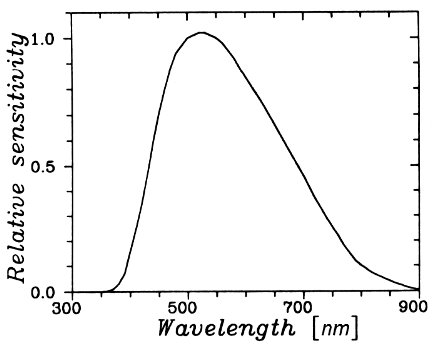
The spectral sensitivity of our technique (normalized to unity at 550 nm)
(Adapted from Borovicka, J. and Bocek, J.: Television spectra of meteors, Earth, Moon, and Planets 71, 237-244, 1995)

At the Ondrejov Observatory, regular TV observations of meteor spectra started in 1990. The limiting magnitude was about +3 and the time resolution was 0.04 s. The observations are being continued during the maxima of major meteor showers with the aim of studying the physics of the meteor phenomenon and to reveal possible chemical and structural differences among the meteoroids of different showers. The presently used instrumentation is summarized in Table. After being digitized by the image processor, the individual frames are analysed by means of a PC.
All frames are being dark-frame subtracted and flat-fielded which allows the lines in the spectrum to be readily identified an measured. Since frequently only the higher and overlapping spectral orders are recorded with only a part of the whole spectrum being in the field of view, the correct identification sometimes represents a challenge. Line intensities are influenced by the sensitivity of the detector at different wavelengths. The spectral sensitivity curve was obtained by the observation of spectra of bright standard stars. The spectral window is wide, the lines from 393.3 nm (Ca II) to 868.0 nm (N I) have actually been observed. The maximal sensitivity is between 500-550 nm.
The TV camera is present only in Ondrejov. As the observed meteors are
too faint to be recorded by the photographic cameras of the fireball network,
no additional information on meteor trajectories and velocities is available.
The membership of a particular shower is inferred from the time of appearance,
direction of flight and the angular velocity.

The spectral sensitivity of our technique (normalized to unity at 550
nm)
(Adapted from Borovicka, J. and Bocek, J.: Television spectra of
meteors, Earth, Moon, and Planets 71, 237-244, 1995)
The description of following images and animations is here (the image with commented spectral lines - 57 kB).
You may download images with a step 0.04 s (about 56 kB each):